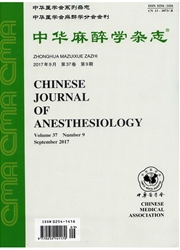

 中文摘要:
中文摘要:
目的 探讨氯胺酮对新生大鼠海马环磷腺苷反应元件结合蛋白(CREB)磷酸化水平的影响.方法 SD大鼠75只,日龄7 d,雌雄不拘,随机分为对照组(C组)、氯胺酮10 mg/kg组(K1组)和氯胺酮20 mg/kg组(K2组),每组25只.K1组和K2组分别皮下注射氯胺酮10、20 mg/kg,C组注射等容量生理盐水,每间隔90 min注射1次,共注射7次.于首次注射后24 h时断头取脑,分离海马,采用TUNEL法检测凋亡神经元,计算凋亡指数;免疫荧光双标法检测p-CREB表达水平;RT-PCR法半定量检测CREB下游基因BDNF mRNA及Bcl-2 mRNA表达水平;于首次注射后6周时采用Morris水迷宫实验测定各组大鼠认知功能.结果 与C组相比,K1组和K2组大鼠海马神经元凋亡指数升高,p-CREB、BDNF mRNA及Bcl-2 mRNA表达下调(P〈0.05);与K1组相比,K2组大鼠海马神经元凋亡指数升高,p-CREB、BDNF mRNA及Bcl-2 mRNA表达下调(P〈0.05);与C组和K1组相比,K2组逃避潜伏期延长(P〈0.05).结论 氯胺酮10、20 mg/kg均可诱导发育期大鼠海马神经元凋亡,而氯胺酮20 mg/kg可导致大鼠发育成熟后认知功能降低,可能与其抑制CREB磷酸化后BDNF及Bcl-2表达下调,导致神经元凋亡,影响大鼠神经系统发育有关.
 英文摘要:
英文摘要:
Objective To investigate the effect of ketamine on cAMP response element binding protein pbosphorylation(p-CREB)in hippocampus of neonatal rats.Methods Seventy-five 7-day old SD rats of both sexes were randomly divided into 3 groups(n=25 each):control group(group C)and 2 ketamlne groups(group K1,K2)which received 7 subcutaneous injections of ketamine 10 and 20 mg/kg respectively at 90 min intervals.The animsla were decapitated at 24 h after fwst ketamine injection.The brains were immediately removed and the hippocampi were isolated for detection of neuronal apoptosis by TUNEL.Apoptosis index wag calculated.The expression of p-CREB Wag meagured by immuno-histochemistry and the expression of BDNF mRNA and Bcl-2 mRNA was detected by RT-PCR.Cognitive function Wag agsessed using Morris water maze test at 6 weeks after first ketamine injection.Results The apoptosis index Wag significantly increased while the expression of CREB,BDNF mRNA and Bcl-2 mRNA was down-regulated in group K1 and K2 as compared with group C.The apoptosis index Wag significantly higher and the expression of p-CREB and BDNF mRNA and Bcl-2 mRNA Wag significantly lower in group K2 than in group K1.The latent period of escape was significantly longer in group K2 than in group C and K1.Conclusion Ketamine 20 mg/kg administered in neonatal rats can decrease cognitive function when they grow up by increasing neuronal apoptosis induced by down-regulatlon of the expression of p-CREB,BDNF and Bcl-2.
 同期刊论文项目
同期刊论文项目
 同项目期刊论文
同项目期刊论文
 期刊信息
期刊信息
